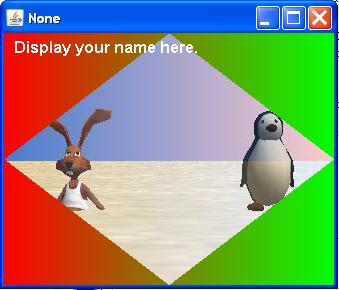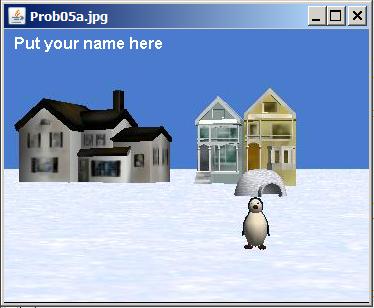| << Chapter < Page | Chapter >> Page > |
What is the meaning of the following two images?
These images were inserted here simply to insert some space between the questions and the answers to keep them from being visible on the screen at thesame time.

This image was also inserted for the purpose of inserting space between the questions and the answers.

True.
True.
44321
True.
443521
True.
True
False. The List interface declares the following overloaded versions of the add method but the Collection interface declares only the first one of the two.
Compiler Error. The method named fillIt receives a reference to an object of the ArrayList class as the interface type Collection , and attempts to call the following overloaded method on that reference:
add(int index, Object element)
However, the Collection interface knows nothing about a method having that signature.
False. It is necessary for objects to implement the Comparable interface to make them eligible for inclusion in a SortedSet .
True.
False. The fact that the location of each element can be controlled in a List is what causes a List to be an ordered collection.
| Listing 1 . Comparable01.java. |
|---|
//File Comparable01.java
import java.util.*;public class Comparable01{
public static void main(String args[]){
new Worker().doIt();}//end main()
}//end class Comparable01class Worker{
public void doIt(){Iterator iter;
Collection ref;ref = new ArrayList();
Populator.fillIt(ref);iter = ref.iterator();
while(iter.hasNext()){System.out.print(iter.next());
}//end while loopSystem.out.println();
}//end doIt()}// end class Worker
class Populator{public static void fillIt(Collection ref){
ref.add(0,new MyClass(4));ref.add(1,new MyClass(4));
ref.add(2,new MyClass(3));ref.add(3,new MyClass(2));
ref.add(4,new MyClass(1));}//end fillIt()
}//end class Populatorclass MyClass{
int data;MyClass(){
data = 0;}//end noarg constructor
MyClass(int data){this.data = data;
}//end parameterized constructorpublic String toString(){
return "" + data;}//end overridden toString()
}//end MyClass |
| Listing 2 . Comparable02.java. |
|---|
//File Comparable02.java
import java.util.*;public class Comparable02{
public static void main(String args[]){
new Worker().doIt();}//end main()
}//end class Comparable02class Worker{
public void doIt(){Iterator iter;
Collection ref;ref = new ArrayList();
Populator.fillIt(ref);iter = ref.iterator();
while(iter.hasNext()){System.out.print(iter.next());
}//end while loopSystem.out.println();
}//end doIt()}// end class Worker
class Populator{public static void fillIt(Collection ref){
((List)ref).add(0,new MyClass(4));((List)ref).add(1,new MyClass(4));
((List)ref).add(2,new MyClass(3));((List)ref).add(3,new MyClass(2));
((List)ref).add(4,new MyClass(1));((List)ref).add(3,new MyClass(5));
}//end fillIt()}//end class populator
class MyClass{int data;
MyClass(){data = 0;
}//end noarg constructorMyClass(int data){
this.data = data;}//end parameterized constructor
public String toString(){return "" + data;
}//end overridden toString()}//end MyClass |
| Listing 3 . Comparable03.java. |
|---|
//File Comparable03.java
import java.util.*;public class Comparable03{
public static void main(String args[]){
new Worker().doIt();}//end main()
}//end class Comparable03class Worker{
public void doIt(){Iterator iter;
Collection ref;ref = new ArrayList();
Populator.fillIt(ref);iter = ref.iterator();
while(iter.hasNext()){System.out.print(iter.next());
}//end while loopSystem.out.println();
}//end doIt()}// end class Worker
class Populator{public static void fillIt(Collection ref){
ref.add(new MyClass(4));ref.add(new MyClass(4));
ref.add(new MyClass(3));ref.add(new MyClass(2));
ref.add(new MyClass(1));}//end fillIt()
}//end class populatorclass MyClass{
int data;MyClass(){
data = 0;}//end noarg constructor
MyClass(int data){this.data = data;
}//end parameterized constructorpublic String toString(){return "" + data;
}//end overridden toString()}//end MyClass |
This section contains a variety of miscellaneous information.
Financial : Although the Connexions site makes it possible for you to download aPDF file for this module at no charge, and also makes it possible for you to purchase a pre-printed version of the PDF file, youshould be aware that some of the HTML elements in this module may not translate well into PDF.
I also want you to know that, I receive no financial compensation from the Connexions website even if you purchase the PDF version ofthe module.
In the past, unknown individuals have copied my modules from cnx.org, converted them to Kindle books, and placed them for sale onAmazon.com showing me as the author. I neither receive compensation for those sales nor do I know who does receive compensation. If youpurchase such a book, please be aware that it is a copy of a module that is freely available on cnx.org and that it was made andpublished without my prior knowledge.
Affiliation : I am a professor of Computer Information Technology at Austin Community College in Austin, TX.
-end-

Notification Switch
Would you like to follow the 'Object-oriented programming (oop) with java' conversation and receive update notifications?